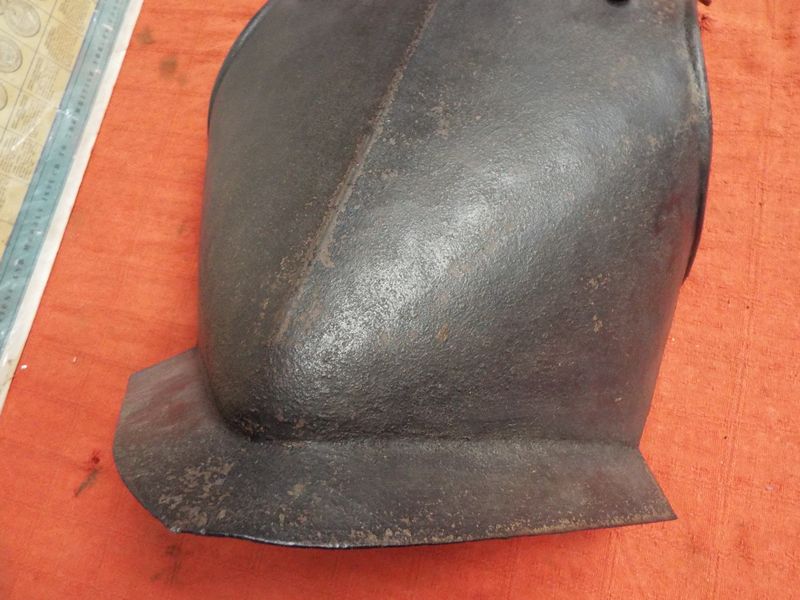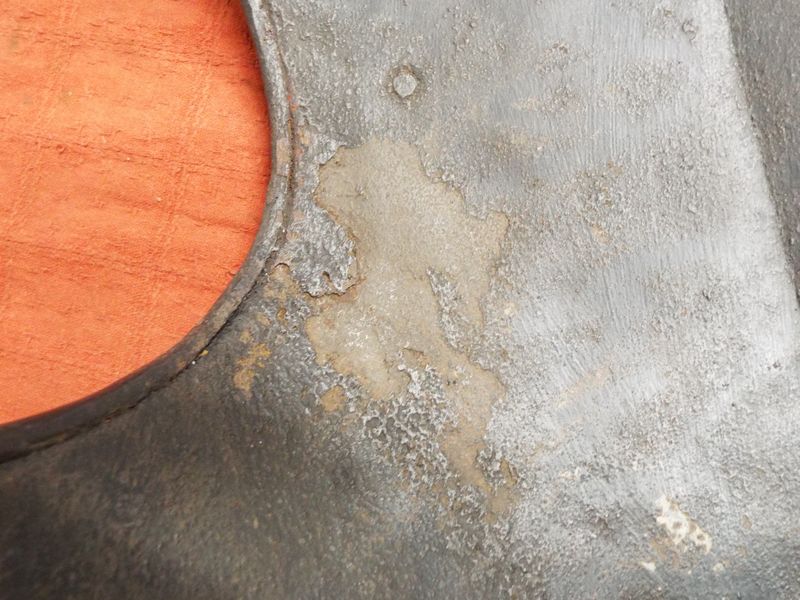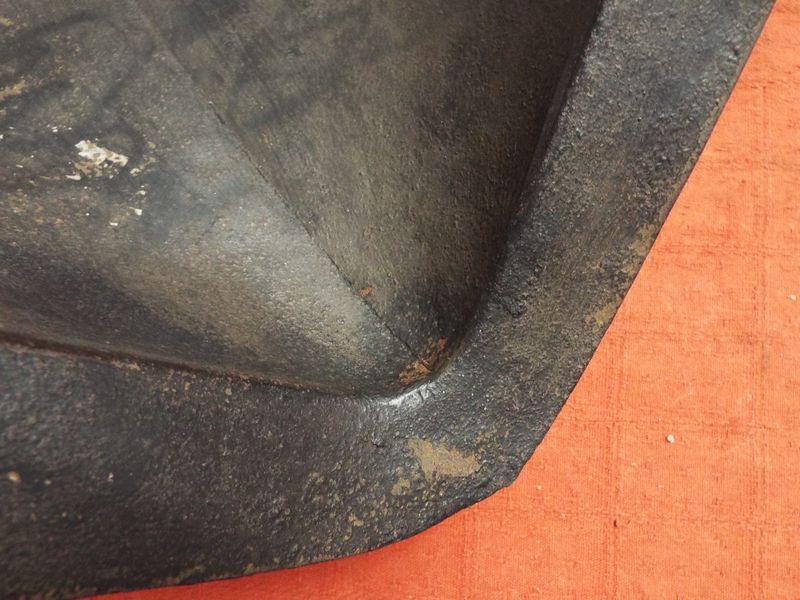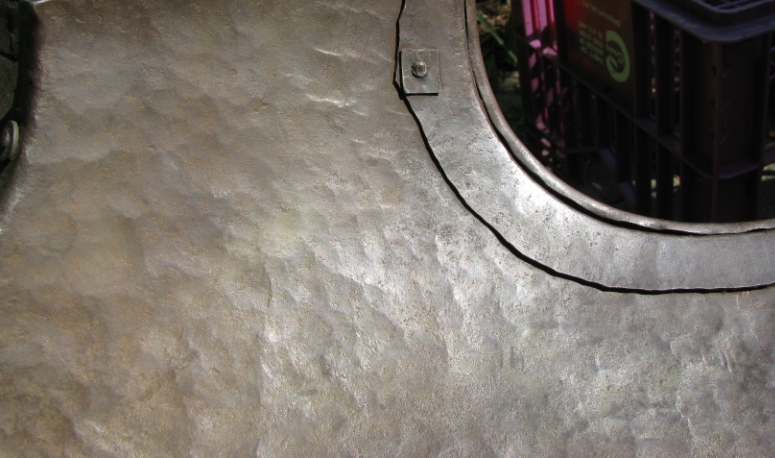| Author |
Message |
|
Tom Wolfe
Location: East Anglia, England Joined: 10 Aug 2015
Posts: 83
|
 Posted: Mon 06 Jun, 2016 2:46 am Post subject: English Civil War breastplate Posted: Mon 06 Jun, 2016 2:46 am Post subject: English Civil War breastplate |
 |
|
Hello gents
I have seen the attached advertised as a genuine English Civil War breadtplate. Nothing particularly rare or unusual about it. I am, however, quite new to this game, so I'd be grateful for any comments on what people could tell me about it.
My view is that it is the right style for the age: the peascod shape would indicate late 16th to mid 17th century dating. As for genuineness: looks OK to me? The blackened finish looks akin to what I'm used to seeing for Civil War armour.
Photos from dealer's website.
What do you gents think of this? Thanks in advance.
 Attachment: 98.03 KB Attachment: 98.03 KB

 Attachment: 87.47 KB Attachment: 87.47 KB

 Attachment: 94.43 KB Attachment: 94.43 KB

 Attachment: 106.79 KB Attachment: 106.79 KB

 Attachment: 99.26 KB Attachment: 99.26 KB

Collector of original 16th-17th century European arms and armour. Would like to collect earlier, but budget doesn't allow- yet!
|
|
  |
 |
Alexander Ehlers

|
 Posted: Mon 06 Jun, 2016 9:56 am Post subject: Posted: Mon 06 Jun, 2016 9:56 am Post subject: |
 |
|
I would say go for it. It looks genuine enough, the edges aren't sharp, the wear is in natural places, and it doesn't look anything too fancy for someone to try and fake it. I am not familiar with those knobs on the front, but I'm not a armour expert though. The only Civil War I'm well acquainted with is the American one.
Never give up without giving a fight, fighting is an opportunity for victory.
|
|
   |
 |
|
Mark Griffin
Location: The Welsh Marches, in the hills above Newtown, Powys. Joined: 28 Dec 2006
Posts: 802
|
 Posted: Mon 06 Jun, 2016 1:31 pm Post subject: Posted: Mon 06 Jun, 2016 1:31 pm Post subject: |
 |
|
The peascod shape would put it a bit earlier than the civil war. by then they have grown shorter, if thats not too mangled a phrase.
Currently working on projects ranging from Elizabethan pageants to a WW1 Tank, Victorian fairgrounds 1066 events and more. Oh and we joust loads!.. We run over 250 events for English Heritage each year plus many others for Historic Royal Palaces, Historic Scotland, the National Trust and more. If you live in the UK and are interested in working for us just drop us a line with a cv.
|
|
  |
 |
James Arlen Gillaspie
Industry Professional

Location: upstate NY Joined: 10 Nov 2005
Posts: 587
|
 Posted: Mon 06 Jun, 2016 6:37 pm Post subject: Posted: Mon 06 Jun, 2016 6:37 pm Post subject: |
 |
|
I don't like it. It smells Victorian to me. What does it weigh? Is the last photo a shot of the inner surface? I see what appears to be a shot of the backside of an armpit roll, and a patch of chipped paint that shows no obvious hammer marks. I don't like the shape I seem to see at the line of the vestigial fauld. Here's a photo of the inside of a typical Italian peascod.
 Attachment: 170.62 KB Attachment: 170.62 KB

jamesarlen.com
|
|
   |
 |
|
Tom Wolfe
Location: East Anglia, England Joined: 10 Aug 2015
Posts: 83
|
 Posted: Mon 06 Jun, 2016 10:31 pm Post subject: Posted: Mon 06 Jun, 2016 10:31 pm Post subject: |
 |
|
| Alexander Ehlers wrote: | | I would say go for it. It looks genuine enough, the edges aren't sharp, the wear is in natural places, and it doesn't look anything too fancy for someone to try and fake it. I am not familiar with those knobs on the front, but I'm not a armour expert though. The only Civil War I'm well acquainted with is the American one. |
Thanks Alexander- the knobs on the front are for the attachment of the shoulder still straps from the backplate. The knobs are mushroom-shaped, and would fit into a keyhole-shaped hole on the end of the shoulder straps.
Collector of original 16th-17th century European arms and armour. Would like to collect earlier, but budget doesn't allow- yet!
|
|
  |
 |
|
Tom Wolfe
Location: East Anglia, England Joined: 10 Aug 2015
Posts: 83
|
 Posted: Mon 06 Jun, 2016 11:01 pm Post subject: Posted: Mon 06 Jun, 2016 11:01 pm Post subject: |
 |
|
| James Arlen Gillaspie wrote: | | I don't like it. It smells Victorian to me. What does it weigh? Is the last photo a shot of the inner surface? I see what appears to be a shot of the backside of an armpit roll, and a patch of chipped paint that shows no obvious hammer marks. I don't like the shape I seem to see at the line of the vestigial fauld. Here's a photo of the inside of a typical Italian peascod. |
I've no idea on the weight- I have only seen it online, not in person, and I haven't handled it. I thought from the photos that it looked quite weighty. Apparent absence of hammer marks is interesting- though I have seen several good examples where the marks are extremely feint. Thanks for your advice.
Collector of original 16th-17th century European arms and armour. Would like to collect earlier, but budget doesn't allow- yet!
|
|
  |
 |
|
Mark Griffin
Location: The Welsh Marches, in the hills above Newtown, Powys. Joined: 28 Dec 2006
Posts: 802
|
 Posted: Tue 07 Jun, 2016 3:16 am Post subject: Posted: Tue 07 Jun, 2016 3:16 am Post subject: |
 |
|
I was waiting for James to weigh in as he's got more experience on this side of things but i concur with everything he says. Its probably a nice later effort but it doesn't say period to me, there too much non standard going on there.
Currently working on projects ranging from Elizabethan pageants to a WW1 Tank, Victorian fairgrounds 1066 events and more. Oh and we joust loads!.. We run over 250 events for English Heritage each year plus many others for Historic Royal Palaces, Historic Scotland, the National Trust and more. If you live in the UK and are interested in working for us just drop us a line with a cv.
|
|
  |
 |
Jonathan Fletcher

|
 Posted: Tue 07 Jun, 2016 11:47 am Post subject: Posted: Tue 07 Jun, 2016 11:47 am Post subject: |
 |
|
My 10p worth...
Avoid any ECW breast/back plates unless you can handle them in the flesh and see delamination of the duplex or triplex construction. The originals I have managed to handle are all duplex at least and some evidence can usually be found along an edge of the armour or where corrosion has eaten through one of the outer layers. Also, consider going for something with armoury marks.
JF
|
|
  |
 |
|
Tom Wolfe
Location: East Anglia, England Joined: 10 Aug 2015
Posts: 83
|
 Posted: Tue 07 Jun, 2016 12:51 pm Post subject: Posted: Tue 07 Jun, 2016 12:51 pm Post subject: |
 |
|
| Jonathan Fletcher wrote: | My 10p worth...
Avoid any ECW breast/back plates unless you can handle them in the flesh and see delamination of the duplex or triplex construction. The originals I have managed to handle are all duplex at least and some evidence can usually be found along an edge of the armour or where corrosion has eaten through one of the outer layers. Also, consider going for something with armoury marks.
JF |
Thanks Jonathan: a further beginner's question- what is "delamination" and how can you spot it? Does it, as the word suggests, concern the layering of different sheets of metal during the forging? And would it then be visible by striations or from a separating or peeling of the layers?
Collector of original 16th-17th century European arms and armour. Would like to collect earlier, but budget doesn't allow- yet!
|
|
  |
 |
Sean Flynt

|
|
   |
 |
Jonathan Fletcher

|
 Posted: Tue 07 Jun, 2016 2:40 pm Post subject: Posted: Tue 07 Jun, 2016 2:40 pm Post subject: |
 |
|
Hi Tom.
Aye exactly! Many of the originals were made from layers of thin sheet welded together: sometimes 2, some 3 and I have seen a 4 somewhere for sale. I suspect this was intentional, as the RA article suggests, something akin to laminated armour on MBT's today. I have a copy of the article somewhere about the study of duplex armours but I don't recall reading any hardness tests of the different layers - will try to find it and post a link.
Look for delamination, or separation of the layers, usually visible where the armour is rolled over at the arm and neck holes and often seen in small sections along the edge of the skirt.
As an anecdote, York Antiques had a stunning '1st century gladiators sword' for a very reasonable price about 6 months ago and I would normally steer well clear of antiquities for fear of good fakes (and did in this case for want of the asking price!) but from getting a close look at it, it was a convincing original Pompeii gladius; the method of construction clearly visible in the tang where the outer jacket of iron/steel had separated away from the innermost core of the blade. My eyes nearly popped out of my head, especially as you could have hilted it up and put it to use after nearly 2000 years.
Good luck.
|
|
  |
 |
|
Tom Wolfe
Location: East Anglia, England Joined: 10 Aug 2015
Posts: 83
|
 Posted: Wed 08 Jun, 2016 1:30 am Post subject: Posted: Wed 08 Jun, 2016 1:30 am Post subject: |
 |
|
| Jonathan Fletcher wrote: | Hi Tom.
Aye exactly! Many of the originals were made from layers of thin sheet welded together: sometimes 2, some 3 and I have seen a 4 somewhere for sale. I suspect this was intentional, as the RA article suggests, something akin to laminated armour on MBT's today. I have a copy of the article somewhere about the study of duplex armours but I don't recall reading any hardness tests of the different layers - will try to find it and post a link.
Look for delamination, or separation of the layers, usually visible where the armour is rolled over at the arm and neck holes and often seen in small sections along the edge of the skirt.
As an anecdote, York Antiques had a stunning '1st century gladiators sword' for a very reasonable price about 6 months ago and I would normally steer well clear of antiquities for fear of good fakes (and did in this case for want of the asking price!) but from getting a close look at it, it was a convincing original Pompeii gladius; the method of construction clearly visible in the tang where the outer jacket of iron/steel had separated away from the innermost core of the blade. My eyes nearly popped out of my head, especially as you could have hilted it up and put it to use after nearly 2000 years.
Good luck. |
Jonathan and Sean- thank you very much both for yoir further advice. I'll take a look at the link to the Royal Armouries article later today. I really appreciate the help and knowledge-sharing that all users on this forum are happy to engage in. Thanks again to you all.
Collector of original 16th-17th century European arms and armour. Would like to collect earlier, but budget doesn't allow- yet!
|
|
  |
 |
|
|

